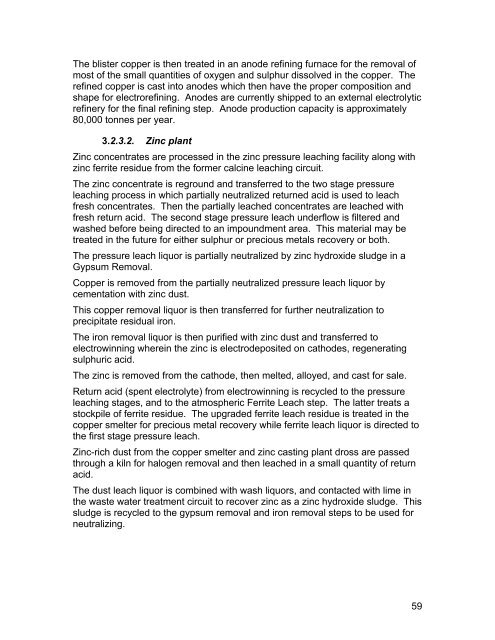(MERAF) for the Base Metals Smelting Sector - CCME
(MERAF) for the Base Metals Smelting Sector - CCME
(MERAF) for the Base Metals Smelting Sector - CCME
Create successful ePaper yourself
Turn your PDF publications into a flip-book with our unique Google optimized e-Paper software.
The blister copper is <strong>the</strong>n treated in an anode refining furnace <strong>for</strong> <strong>the</strong> removal of<br />
most of <strong>the</strong> small quantities of oxygen and sulphur dissolved in <strong>the</strong> copper. The<br />
refined copper is cast into anodes which <strong>the</strong>n have <strong>the</strong> proper composition and<br />
shape <strong>for</strong> electrorefining. Anodes are currently shipped to an external electrolytic<br />
refinery <strong>for</strong> <strong>the</strong> final refining step. Anode production capacity is approximately<br />
80,000 tonnes per year.<br />
3.2.3.2. Zinc plant<br />
Zinc concentrates are processed in <strong>the</strong> zinc pressure leaching facility along with<br />
zinc ferrite residue from <strong>the</strong> <strong>for</strong>mer calcine leaching circuit.<br />
The zinc concentrate is reground and transferred to <strong>the</strong> two stage pressure<br />
leaching process in which partially neutralized returned acid is used to leach<br />
fresh concentrates. Then <strong>the</strong> partially leached concentrates are leached with<br />
fresh return acid. The second stage pressure leach underflow is filtered and<br />
washed be<strong>for</strong>e being directed to an impoundment area. This material may be<br />
treated in <strong>the</strong> future <strong>for</strong> ei<strong>the</strong>r sulphur or precious metals recovery or both.<br />
The pressure leach liquor is partially neutralized by zinc hydroxide sludge in a<br />
Gypsum Removal.<br />
Copper is removed from <strong>the</strong> partially neutralized pressure leach liquor by<br />
cementation with zinc dust.<br />
This copper removal liquor is <strong>the</strong>n transferred <strong>for</strong> fur<strong>the</strong>r neutralization to<br />
precipitate residual iron.<br />
The iron removal liquor is <strong>the</strong>n purified with zinc dust and transferred to<br />
electrowinning wherein <strong>the</strong> zinc is electrodeposited on cathodes, regenerating<br />
sulphuric acid.<br />
The zinc is removed from <strong>the</strong> cathode, <strong>the</strong>n melted, alloyed, and cast <strong>for</strong> sale.<br />
Return acid (spent electrolyte) from electrowinning is recycled to <strong>the</strong> pressure<br />
leaching stages, and to <strong>the</strong> atmospheric Ferrite Leach step. The latter treats a<br />
stockpile of ferrite residue. The upgraded ferrite leach residue is treated in <strong>the</strong><br />
copper smelter <strong>for</strong> precious metal recovery while ferrite leach liquor is directed to<br />
<strong>the</strong> first stage pressure leach.<br />
Zinc-rich dust from <strong>the</strong> copper smelter and zinc casting plant dross are passed<br />
through a kiln <strong>for</strong> halogen removal and <strong>the</strong>n leached in a small quantity of return<br />
acid.<br />
The dust leach liquor is combined with wash liquors, and contacted with lime in<br />
<strong>the</strong> waste water treatment circuit to recover zinc as a zinc hydroxide sludge. This<br />
sludge is recycled to <strong>the</strong> gypsum removal and iron removal steps to be used <strong>for</strong><br />
neutralizing.<br />
59
















